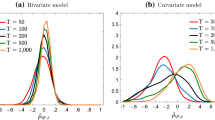Abstract
This article establishes stylized facts about the cyclicality of real consumer wages and real producer wages in Germany. As detrending methods, we apply the Beveridge–Nelson decomposition, the Hodrick–Prescott filter, the Baxter–King filter, and the structural time series model. The detrended data are analyzed both in the time domain and in the frequency domain. The great advantage of an analysis in the frequency domain is that it allows to assess the relative importance of particular frequencies for the behavior of real wages. We propose to use the phase angle as a suitable measure to get detailed information about the correlation and the lead–lag behavior of real wages relative to GDP at different frequencies. In the time domain, we find that both real wages display a procyclical pattern and lag behind the business cycle. In the frequency domain, the consumer real wage lags behind the business cycle and shows an anticyclical behavior for shorter time periods, whereas for longer time spans a procyclical behavior can be observed. For the producer real wage, however, the results in the frequency domain remain inconclusive.
Similar content being viewed by others
References
Abraham KG, Haltiwanger JC (1995) Real wages and the business cycle. J Econ Lit 33(3): 1215–1264
Anger S (2007) The cyclicality of effective wages within employer–employee matches: evidence from German panel data. Working Paper 783, ECB
Barro RJ (1990) Macroeconomics, 3rd edn. Wiley, New York
Barro RJ, King RG (1984) Time-separable preferences and intertemporal-substitution models of business cycles. Q J Econ 99(4): 817–839
Bauer T, Bonin H, Goette L, Sunde U (2007) Real and nominal wage rigidities and the rate of inflation: evidence from West German micro data. Econ J 117: 508–529
Baxter M, King RG (1999) Measuring business cycles. Approximate band-pass filters for economic time series. Rev Econ Stat 81(4): 575–593
Beveridge S, Nelson CR (1981) A new approach to decomposition of economic time series into permanent and transitory components with particular attention to measurement of the ’business cycle’. J Monet Econ 7: 151–174
Brandner P, Neusser K (1992) Business cycles in open economies: stylized facts for Austria and Germany. Rev World Econ 128(1): 67–87
Brandolini A (1995) In search of a stylized fact: do real wages exhibit a consistent pattern of cyclical variability?. J Econ Surv 9(2): 103–163
Burns AF, Mitchell WC (1946) Measuring business cycles. NBER, New York
Christiano LJ, Eichenbaum M (1992) Current real-business-cycle theories and aggregate labor-market fluctuations. Am Econ Rev 82(3): 430–450
Cogley T, Nason JT (1995) Effects of the Hodrick–Prescott filter on the trend and difference stationary time series: implications for business cycle research. J Econ Dyn Control 19: 253–278
Commandeur JJF, Koopman SJ (2007) An introduction to state space time series analysis. Oxford University Press, New York
Croux C, Forni M, Reichlin L (2001) A measure of comovement for economic variables: theory and empirics. Rev Econ Stat 83(2): 232–241
den Haan WJ (2000) The comovement between output and prices. J Monet Econ 46: 3–30
Engle RF, Kozicki S (1993) Testing for common features. J Bus Econ Stat 11(4): 369–380
Gomez V (2001) The use of butterworth filters for trend and cycle estimation in economic time series. J Bus Econ Stat 19(3): 365–373
Hart RA, Malley JR, Woitek U (2009) Real earnings and business cycles: new evidence. Empir Econ 37: 51–71
Harvey AC (1989) Forecasting, structural time series models and the Kalman filter. Cambridge University Press, Cambridge
Harvey AC, Jaeger A (1993) Detrending, stylized facts and the business cycle. J Appl Econom 8: 231–247
Harvey AC, Koopman JS (1992) Diagnostic checking of unobserved-component time series models. J Bus Econ Stat 10(4): 377–389
Harvey AC, Streibel M (1998) Tests for deterministic versus indeterministic cycles. J Time Ser Anal 19: 505–529
Harvey AC, Trimbur TM (2003) General model-based filters for extracting cycles and trends in economic time series. Rev Econ Stat 85(2): 244–255
Koopman JS (1993) Disturbance smoother for state space models. Biometrika 80(1): 117–126
Koopman SJ, Shephard N, Doornik JA (2008) SsfPack 3.0: statistical algorithms for models in state space form. Timberlake Consultants, London
Koopman SJ, Harvey AC, Doornik JA, Shephard N (2009) STAMP 8.2: structural time series analyser, modeller and predictor. Timberlake Consultants, London
Koopmans LH (1974) The spectral analysis of time series. Academic Press, London
Kydland FE, Prescott EC (1982) Time to build and aggregate fluctuations. Econometrica 50: 1345–1370
Lucke B (1997) An Adelman-test for growth cycles in West Germany. Empir Econ 22: 15–40
Mastromarco C, Woitek U (2007) Regional business cycles in italy. Comput Stat Data Anal 52: 907–918
Messina J, Strozzi C, Turunen J (2009) Real wages over the business cycle: OECD evidence from the time and frequency domains. J Econ Dyn Control 33(6): 1183–1200
Murray CJ (2003) Cyclical properties of Baxter–King filtered time series. Rev Econ Stat 85(2): 472–476
Newbold P (1990) Precise and efficient computation of the Beveridge-Nelson decomposition of economic time series. J Monet Econ 26: 453–457
Peng F, Siebert WS (2007) Real wage cyclicality in Germany and the UK: new results using panel data. Working Paper 2688, IZA
Pérez PJ (2001) Cyclical properties in the main western economies. Working Paper 33, The University of Manchester
Priestley MB (1981) Spectral analysis and time series. Academic Press, London
Rotemberg JJ, Woodford M (1991) Markups and the business cycle. In: Blanchard O, Fisher S (eds) NBER Macroeconomics Annual:1991. MIT Press, Cambridge, London, pp 63–129
Schirwitz B (2009) A comprehensive German business cycle chronology. Empir Econ 37: 287–301
Tripier F (2002) The dynamic correlation between growth and unemployment. Econ Bull 5(4): 1–9
Vahid F, Engle RF (1997) Codependent cycles. J Econom 80: 199–221
Author information
Authors and Affiliations
Corresponding author
Rights and permissions
About this article
Cite this article
Marczak, M., Beissinger, T. Real wages and the business cycle in Germany. Empir Econ 44, 469–490 (2013). https://doi.org/10.1007/s00181-011-0542-4
Received:
Accepted:
Published:
Issue Date:
DOI: https://doi.org/10.1007/s00181-011-0542-4
Keywords
- Real wages
- Business cycle
- Frequency domain
- Phase angle
- Time domain
- Trend-cycle decomposition
- Structural time series model
- Germany




